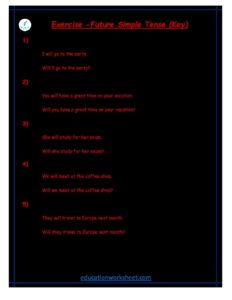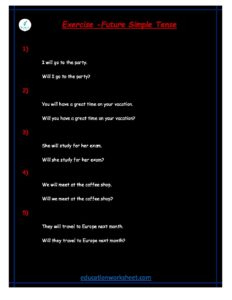changing Future Simple Tense to positive and interrogative worksheets
changing Future Simple Tense to positive and interrogative

The Future Simple Tense, also known as the Simple Future Tense, is a fundamental tense in the English language used to express actions or events that will happen in the future. It is a versatile tense that can be easily transformed into both positive and interrogative sentences, providing a valuable tool for effective communication. In this extensive exploration, we will delve into the mechanics of converting Future Simple Tense sentences from affirmative to interrogative, unraveling the intricacies of English grammar to facilitate an in-depth understanding of this transformation.
changing Future Simple Tense to positive and interrogative worksheets
The Future Simple Tense, in its affirmative form, is constructed using the modal auxiliary verb “will” followed by the base form of the main verb. For example, “She will travel to Paris.” This sentence predicts a future action – in this case, traveling to Paris. To change this sentence to an interrogative form, we need to invert the word order and add a question word or phrase. Interrogative sentences are used to ask questions, seek information, or elicit a response. There are several methods to convert the Future Simple Tense from positive to interrogative, and we will explore them in detail in this discussion.
changing Future Simple Tense to positive and interrogative worksheets

One common way to change a positive Future Simple Tense sentence to an interrogative one is by using inversion. Inversion is the process of reversing the order of the subject and the auxiliary verb. To do this, we place the auxiliary verb “will” before the subject, and the result is an interrogative sentence. For example, “Will she travel to Paris?” In this sentence, the subject “she” comes after the auxiliary verb “will,” and the question is formed by simply adding a question mark at the end. The question word “will” has been placed at the beginning of the sentence to create an interrogative structure.
It’s important to note that inversion can be used with any subject pronoun. For instance, “Will I travel to Paris?” or “Will they travel to Paris?” Interrogative sentences formed in this manner are versatile and can be used to ask a wide range of questions about future actions or events.
Another method to convert a positive Future Simple Tense sentence to an interrogative one is by using question words or phrases. Question words, such as “who,” “what,” “where,” “when,” “why,” and “how,” are added to the beginning of the sentence to form a question. For example, “Where will she travel?” In this sentence, the question word “where” has been added at the beginning to specify the aspect of the action being questioned – the destination. The auxiliary verb “will” remains in its original position after the subject “she.”
changing Future Simple Tense to positive and interrogative worksheets
Question words or phrases can be used to gather specific information about future actions, making them particularly useful when the nature of the question is more complex or when the answer requires additional details. For instance, “How will they travel to Paris?” This question word “how” inquires about the manner in which the action will be carried out.
To further illustrate the transformation from positive to interrogative Future Simple Tense sentences, we can explore a variety of examples across different question words:
- Who: “Who will go to the party?”
- What: “What will she cook for dinner?”
- Where: “Where will they build the new school?”
- When: “When will you arrive at the airport?”
- Why: “Why will he quit his job?”
- How: “How will we complete the project on time?”
Question words can be modified to fit the context of the question, making it a flexible and adaptable way to create interrogative sentences.
Additionally, it’s worth mentioning that we can use tag questions to convert positive Future Simple Tense sentences into interrogative ones. Tag questions are short questions added to the end of a statement to seek confirmation or agreement. For example, “You will come to the meeting, won’t you?” In this sentence, the tag question “won’t you” transforms the statement into an interrogative sentence. Tag questions are typically constructed by using the auxiliary verb from the affirmative sentence with its subject pronoun, and the negative or positive form depends on the original statement. For a positive statement, a negative tag is used, and for a negative statement, a positive tag is used. For instance:
- Positive Statement: “She will visit next week, won’t she?”
- Negative Statement: “They won’t attend the concert, will they?”
Tag questions can be effective in engaging the listener and prompting a response.
Moreover, changing Future Simple Tense sentences to interrogative form can involve variations in the auxiliary verbs. While “will” is the most common auxiliary verb used in the Future Simple Tense, it is not the only one. “Shall” can also be used in affirmative sentences, especially in British English. To convert a sentence with “shall” to an interrogative form, the same principles of inversion, question words, and tag questions apply. For instance:
- Affirmative with “Shall”: “I shall call you tomorrow.”
- Interrogative with Inversion: “Shall I call you tomorrow?”
- Interrogative with Question Word: “When shall I call you?”
- Interrogative with Tag Question: “You shall call me tomorrow, shan’t you?”
Additionally, for negative Future Simple Tense sentences, “will not” or the contraction “won’t” is used. The conversion of negative sentences to interrogative form is similar to positive sentences. For instance:
- Negative Statement: “She won’t attend the conference.”
- Interrogative with Inversion: “Won’t she attend the conference?”
- Interrogative with Question Word: “Why won’t she attend the conference?”
- Interrogative with Tag Question: “She won’t attend the conference, will she?”
As we’ve explored, the transformation of Future Simple Tense sentences from positive to interrogative can be achieved through various methods, each offering a distinct way to ask questions about future actions or events. These methods include inversion, question words, and tag questions. Additionally, we’ve seen how both “will” and “shall” can be used as auxiliary verbs, and how they can be adapted to interrogative sentences. Moreover, negative sentences can also be converted to interrogative form using the same techniques.
In summary, the Future Simple Tense in English is a powerful tool for expressing future actions, and the ability to convert these sentences to both positive and interrogative forms enhances one’s ability to communicate effectively. Whether you’re inquiring about plans, making predictions, or seeking information about the future, understanding how to change Future Simple Tense sentences from positive to interrogative is a valuable skill in mastering the English language. This comprehensive exploration has shed light on the various methods and nuances involved in this transformation, equipping you with the knowledge to construct and understand a wide range of future-focused questions.

